Konstrukcja - reprodukcja. Grafika, fotografia i film w konstruktywizmie polskim.
Construction - reproduction. Graphic arts, photography and film in Polish Constructivism
Author(s): Marcin GiżyckiSubject(s): Theatre, Dance, Performing Arts
Published by: Instytut Sztuki Polskiej Akademii Nauk
Keywords: Constructivism; photography
Summary/Abstract: Giżycki deals with the problem of an interest in photography and film, shown by Polish avantgarde artists from its beginnings. According to Giżycki, photomontage, film, prints made of typographic elements, and first of all film collage were the means that were perfectly suitable for the realisation of Constructivist ideas. One of the basic aims of Constructivism – to turn towards new materials – could be put in practice through the use of finished and prefabricated elements. Giżycki traces the way in which the artworks were evolving from the “literary quality” of the early photomontages of Mieczysław Szczuka, Teresa Żarnower’s abstract and geometric compositions, Stefan Themerson’s films, inspired by Constructivism "Pharmacy" (1930) and "Europa" (1932) and Jalu Kurek’s ("Rhytmic Calculations", 1932) into typically collage-montage films of Janusz Maria Brzeski ("Sections", 1931; "Concrete", 1933) or his anti-Utopian and anti-industrial series of photomontages "The Robot is Born" (1934). Giżycki also points out that after a period of Utopian projects by artists relishing a regained freedom, the Constructivists expressed through art their, mostly left-wing, political beliefs.
Journal: Kwartalnik Filmowy
- Issue Year: 2006
- Issue No: 54-55
- Page Range: 31-44
- Page Count: 14
- Language: Polish

